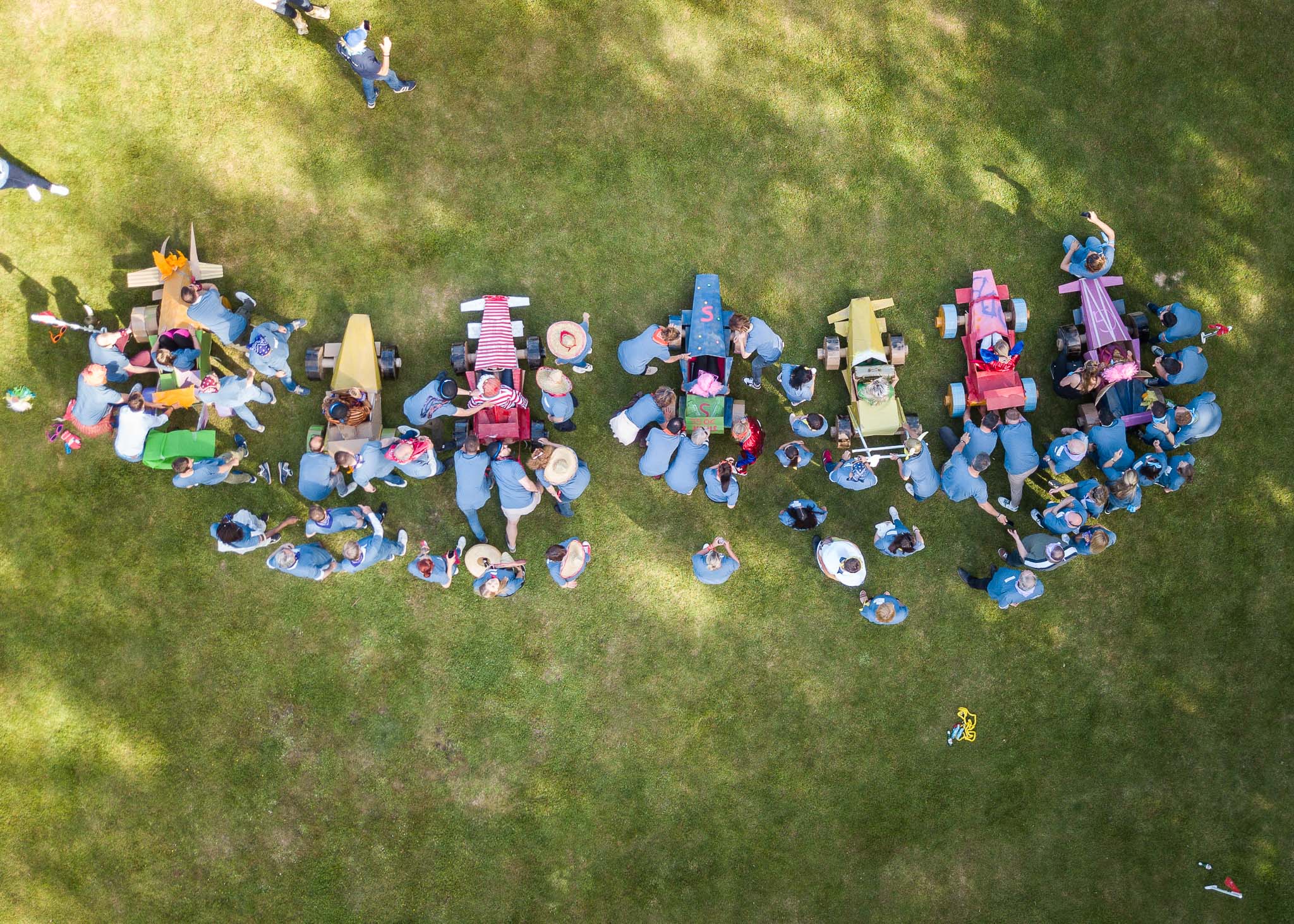02 Nov 2022 . 11 min read
New work dynamics: Why to go for smaller but more frequent team building activities

Remote, Digital and Hybrid Work: The trends that are changing our working life
The working environment and office dynamics have experienced huge changes in the past few years, and we are still far from seeing an end to it. Many companies and managers are struggling to understand where the new trends are pointing at, and how to adapt to keep everything operating, and having at the same time happy and engaged employees.
There are 3 big trends that are consolidating, and will affect how the daily office routines are organized. On the one hand, there’s more and more remote work. Stats and surveys show that 84% of French and Belgian companies plan to have 40% of their employees working from home towards the end of 2023, and business travel worldwide has already decreased 72% in 2021. On the other hand, 75% of meetings will be digital by 2024, compared to 25% today. Added to this, it is estimated that 65% of workers will be self-employed by 2035 (the so called Digital Nomads).
These 3 strong trends combined are taking us to a hybrid working environment and creating a new need to be more proactive to reinforce connection between teams, and unite these people in a corporate culture. As the office dynamic is less frequent, there’s a necessity to recreate the connection that was built in daily physical interactions, coffee and lunch breaks, hallway talks, and after office gatherings. Although research shows that flexibility is greatly valued by most employees, there’s also evidence that people working fully remote are slightly more disengaged, so there can be drawbacks if virtual working is not planned in a thoughtful way.
In order to be aligned on how work in the future will be, one of the new tendencies in Team Building is to organize more frequent smaller activities, with the final objective of reinforcing and recreating this connection among colleagues. The events can be digital, physical, or combined. Prepared as part of a yearly planning, they can be designed as checkpoints leading to a bigger physical event towards the end of the year.
The final objective is to build an interconnection and integration between work and team building and not having each one isolated from the other, so as to recreate a dynamic office environment while working remotely.

Pros and challenges of having more frequent and smaller events
The new reality shown by these trends is a challenge for HR and team managers. They have to be creative to find new tools to connect employees, foster people to people interactions and communications in a team, as a way of having everyone in the company aligned, engaged, and motivated.
Given this context, let’s go over some of the advantages of organizing more frequent smaller team building events:
- It’s a great way to keep a dialogue and connection box open all year long, having a positive influence on employee engagement.
- It allows to interconnect recreation moments with work routines. For example, a small activity can be organized before, during, or after a meeting.
- It provides a casual context to get to know your colleagues better, and this can compensate for the lack of physical interaction that’s reduced due to remote working.
- When integrating digital tools and activities, the environmental impact is limited, as there’s a reduction of the need for logistics, and less travel.
- It’s a change of mindset. Each activity can have its own objectives and rewards, building towards a big final objective in the end. This will help increase everyone’s commitment to the activities and common goals.
The biggest challenge of this approach is that it requires a more thorough and well thought long term planning. Each small activity should have its own goals, but at the same time be part of an integral strategy, building towards a final common goal. In terms of budget, organizing several activities and events can seem more expensive than doing just one or two per year, but when it’s considered as an integral investment on employee engagement, the ROI that this strategy can bring makes it worthy to go for it.
Tips for planning frequent team building activities
Although the signs of this evolution in the working environment are quite clear, the need to change the focus on how team building is organized is not evident for all. Most managers realize that something needs to be done, but they don’t know yet how to deal with it.
There are a few tips to consider in order to overcome the challenges presented in this situation, and take advantage of the opportunities given by the new trends:
- Plan ahead. Have a yearly plan with checkpoints building up towards a bigger event as an end point.
- Have clear objectives and goals, both for each individual event, and for the integral Team Building approach. Each checkpoint can have different goals: Improve skills, have fun, solve a specific work problem, learn something new. And the whole strategy can have a general HR objective, like improving connection and increasing employee engagement, or a common goal to be achieved together, like raising money for a charity or reducing the company carbon footprint.
- Be strategic. Have an integral approach instead of an isolated one, focused on each individual event. Think about what do you want to achieve, why do you want to do it, and how do you plan to accomplish the final goals. Our specialists are there to help with the strategy and execution of the plan.
- Consider what employees like when thinking of which activities to do. Ask for their input and feedback. Plan diverse activities so everyone feel happy and involved. For example, some activities can be physical, some digital, others can be combined. Take into account the diverse interests that people in your teams may have: cultural, tech-oriented, sporty, etc.
- Try to integrate the team building events into the working routine in an organic way. The checkpoints can be a combination of a moment of sharing, a meeting, a learning moment and a team building that comes after.
- Make sure the challenges give a sense of rewarding when accomplished, so the participants have a feeling of achievement and get committed when participating. If each objective is fulfilled during the small events and activities that act as checkpoints, then the final event will be more succesfull and everyone will enjoy it more, as they’ll feel they deserve it.
The best short team building activities to do more frequently
There are both physical and digital team building activities and events that can be organized under this approach, and are ideal to be easily integrated into the work routine and environment.
City play is a great example of an in-person activity that can be organized for teams that are working virtually and not seeing each other much, but are still on the same city. It can be organized to be done in 1 or 2 hours, great to fit any schedule, and a perfect option to end your work meetings. Pathfinder and Bike Tour are other great alternatives for this scenarios.
Among the digital offer, enriched with the innovative team building and gaming experiences offered by the Wannapplay department, some great options to include as team building checkpoints during the year are the Quiz play, TV Quiz game and Online music quiz, the Visio detective, and the wine connect. Online talks are also a great opportunity to strengthen some skills in the team and boost motivation with interesting speakers.
And going one step further, the possibilities will grow exponentially if we consider the opportunities that the metaverse will bring to complement and enrich team building activities. It will allow to extend our ecosystems into the digital world, having at the same time physical and digital/dematerialised venues and activities, as an extension of face-to-face events and experiences.
At Tero Team Building we are already working on developments and projects aimed on this direction. Taking advantage of a more immersive digital space, the interconnection between physical and virtual will multiply the possibility of generating activities and intensify all kind of people to people interactions. Our central mission is reconnection, but the metaverse will become a powerful tool to potentiate it and help build an augmented reconnection.
Time to start planning!
The deep changes that we are experiencing in the work environment require us to take action and address the new needs that emerged. And at the same time, the clear trend towards digitalization, innovation, and flexibility gives us great tools to plan ahead and develop the ideal team building activities to deal with the need for reconnection.
Get in touch with us, and we will help you with a structured and strategic long term team building planning, with shorter activities as frequent checkpoints, and pointing towards a bigger event in the end. We will work together to identify clear goals, set objectives for each activities and find the ideal strategy to achieve them!